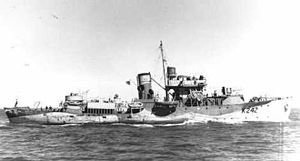HMCS Ville de Quebec (K242)

HMCS Ville de Québec
|
|
| History | |
|---|---|
|
|
|
| Name: | Ville de Québec |
| Namesake: | Quebec City, Quebec |
| Builder: | Morton Engineering and Dry Dock Co., Quebec City |
| Laid down: | 7 June 1941 |
| Launched: | 12 November 1941 |
| Commissioned: | 24 May 1942 |
| Decommissioned: | 6 July 1945 |
| Identification: | Pennant number: K242 |
| Honours and awards: |
Atlantic 1942–1944, Mediterranean 1943, English Channel 1944–1945; Gulf of St. Lawrence |
| Fate: | Sold for mercantile use |
| General characteristics | |
| Class and type: | Flower-class corvette (Revised) |
| Displacement: | 925 long tons (940 t; 1,036 short tons) |
| Length: | 205 ft (62.48 m)o/a |
| Beam: | 33 ft (10.06 m) |
| Draught: | 11.5 ft (3.51 m) |
| Propulsion: |
|
| Speed: | 16 knots (29.6 km/h) |
| Range: | 3,500 nautical miles (6,482 km) at 12 knots (22.2 km/h) |
| Complement: | 85 |
| Sensors and processing systems: |
|
| Armament: |
|
HMCS Ville de Québec was a Royal Canadian Navy revised Flower-class corvette which took part in convoy escort duties during the Second World War. She fought primarily in the Battle of the Atlantic. She was named for Quebec City, Quebec. Following the war, the ship was sold to commercial interests, in service until 1952.
Flower-class corvettes like Ville de Québec serving with the Royal Canadian Navy during the Second World War were different from earlier and more traditional sail-driven corvettes. The "corvette" designation was created by the French as a class of small warships; the Royal Navy borrowed the term for a period but discontinued its use in 1877. During the hurried preparations for war in the late 1930s, Winston Churchill reactivated the corvette class, needing a name for smaller ships used in an escort capacity, in this case based on a whaling ship design. The generic name "flower" was used to designate the class of these ships, which – in the Royal Navy – were named after flowering plants.
Corvettes commissioned by the Royal Canadian Navy during the Second World War were named after communities for the most part, to better represent the people who took part in building them. This idea was put forth by Admiral Percy W. Nelles. Sponsors were commonly associated with the community for which the ship was named. Royal Navy corvettes were designed as open sea escorts, while Canadian corvettes were developed for coastal auxiliary roles which was exemplified by their minesweeping gear. Eventually the Canadian corvettes would be modified to allow them to perform better on the open seas.
Ville de Québec was ordered as part of the Revised 1940–41 Flower-class building program. This revised program radically changed the look of the Flower-class corvette. The ships of this program kept the water-tube boilers of the initial 1940–41 program, but now they were housed in separate compartments for safety. The fo'c'sle was extended, which allowed more space for berths for the crew, leading to an expansion of the crew. The bow had increased flare for better control in heavy seas. The revised Flowers of the RCN received an additional two depth charge throwers fitted amidships and more depth charges. They also came with heavier secondary armament with 20 mm anti-aircraft guns carried on the extended bridge wings. All this led to an increase in displacement, draught and length.
...
Wikipedia
